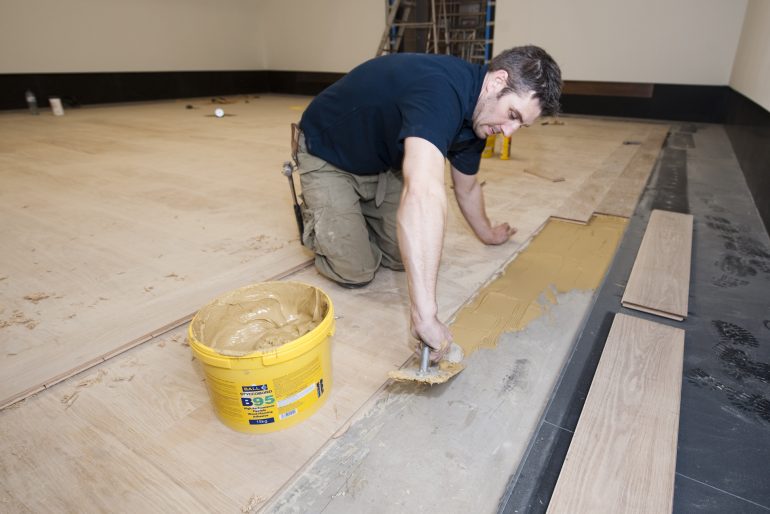Q. Can I apply Stopgap 500 Micro over Stopgap 1100 Gypsum?
A. You can, as long as the levelling compound is dry. F. Ball’s Stopgap 500 Micro flooring finishing compound can be applied over plywood, sand/cement screeds, calcium sulphate screeds, other rigid dry absorbent surfaces and Stopgap levelling compounds, including Stopgap 1100 Gypsum.
Q. I want to apply a flexible levelling compound over a painted concrete screed in an industrial unit. What preparation is required to remove the paint?
A. Mechanical preparation will be required before the application of a levelling compound to ensure proper adhesion to the substrate, avoiding the potential for de-bonding to occur, which could potentially cause complete floor failure. Methods include dust-free shot/grit blasting and mechanical planing, scabbling, grinding or abrading. Hand tools may also be used for edges and hard to reach areas. You must then make sure the subfloor is suitably sound and dry, removing any dust and debris and conducting a moisture test to determine the requirement for a waterproof surface membrane. Where subfloor relative humidity levels are above 75% (65% if wood floorcoverings will be installed) a waterproof surface membrane will be required to prevent excess subfloor moisture causing floor failure.
Q. What should I use to adhere solid oak floorcoverings to a concrete subfloor.
A. Styccobond B95, F. Ball’s high performance, flexible wood adhesive. It’s a one-part, moisture curing polyurethane adhesive that is specially designed to accommodate natural movement in wood flooring over its lifetime. Wood floorcoverings are particularly susceptible to moisture damage, so as well as checking the subfloor is suitably sound and smooth, conduct a moisture test. If subfloor relative humidity levels are 65% or above, a waterproof surface membrane should be applied before the installation of wood floorcoverings.
Q. Wooden blocks installed on the ground floor of a 100-year-old property are beginning to lift.
A. This is likely because of damp. It wasn’t until 1965 that new building regulations made it a legal requirement to install a structural damp proof course in new buildings, so there is likely no moisture management system in place. You will need to remove the floorcoverings and then apply a waterproof surface membrane, such as F. Ball’s Stopgap F77, which creates a barrier against subfloor relative humidity levels of up to 98% with a single application. You can then bond the floorcoverings directly to the waterproof membrane within 24 hours of curing using Styccobond B95.
Q. I want to install vinyl safety flooring on a vertical steel surface. What should I use?
A. You can use Stycco Flex, F. Ball’s recently reformulated, flexible tube adhesive. Enhanced dimensional stability and excellent plasticiser resistance have enabled 100% compatibility with PVC flooring accessories, such as skirting, capping and coving. If you’re working up the wall, and you only want to use one adhesive, you may opt for Styccobond F49 Hybrid PS instead. It’s a pressure sensitive, temperature tolerant vinyl adhesive for installing vinyl floorcoverings over a wide range of subfloor types. It is also approved for installing vinyl floorcoverings on vertical surfaces.
Q. I want to apply Stopgap 600 Base over a waterproof surface membrane. Do I need to prime?
A. Yes. Priming over non-absorbent surfaces, such as waterproof surface membranes and ceramic tiles, is essential before applying a levelling compound. This is to promote bond performance between subfloor and levelling compound. F. Ball’s Stopgap P141 primer has been developed especially to enhance the bond performance between its floor levelling compounds and non-absorbent subfloors. It is particularly recommended where Stopgap 600 deep base levelling compound is applied at a thickness greater than 20mm to non-absorbent surfaces. The strong bond created when using Stopgap P141 is better able to withstand the increased stress that thicker depths of levelling compound exert when drying.
Q. Can I apply Styccobond F48 PLUS directly over an anhydrite screed?
That’s fine if the base is laitance and dust free and subfloor relative humidity levels are below 75%. However, the application of a levelling compound is recommended to create a perfectly smooth base for the receipt of floorcoverings; use Stopgap 1100 Gypsum, which is designed for maximum compatibility with calcium sulphate screeds. Whether you are applying a levelling compound or proceeding straight to the installation of floorcoverings, prime the subfloor beforehand using two coats of F. Ball’s primer for use over calcium sulphate screeds, Stopgap P121. The first coat should be diluted with water at a ratio of 1:1. The second coat should be applied neat.
Our technical team are on standby to answer questions about your projects and F. Ball products from 8.30am – 5.00pm, Monday to Friday.
Please note: site conditions vary. Don’t rely on these specific responses for your own project. If you are unsure about any technical issue relating to specific flooring installations, contact the F. Ball Technical Service team on 01538 361633 or consult the product data sheets available from F. Ball’s website.


